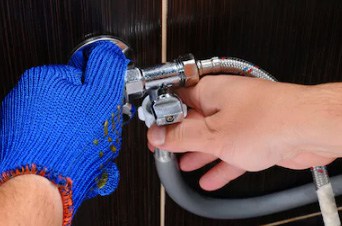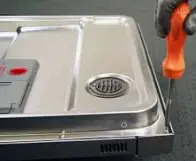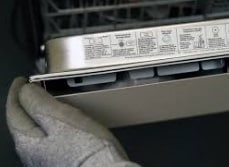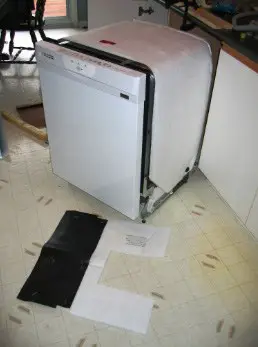Depending on how many dishes your household uses will determine how often you run your dishwasher.
A lot of homes are so busy nowadays that it’s easiest to just throw the dishes in the dishwasher and call it a day.
Excessive noise, called noise pollution, can have negative effects on your health. I’ve decided to research this topic and found the best possible solutions to keeping a dishwasher quiet.
These methods I provide will not completely block out all the sound from your dishwasher.
They will, however limit the amount of noise it will produce by quite a bit. Here are some steps you can take to soundproof your dishwasher.
Internal Soundproofing of Your Dishwasher
This should be your bread and butter when it comes to quieting your noisy dishwasher.
What I mean by internal soundproofing is that you will need to remove your dishwasher from the cabinet wall altogether so we can get to the main culprit of all the noise, the inside.
Soundproofing a dishwasher is one of those things that sounds harder than it actually is.
This method will require a bit of handy work, so if you are not confident in doing this, then you can skip to the bottom of the article, where I talk about everyday tips and tricks when using a loud dishwasher.
For everyone else that is willing to take on this small challenge, here we go.
Make Sure Your Dishwasher Is Completely Off

This step is very important to make sure you don’t make a mess or damage your dishwasher in any way.
Locate your dishwasher’s power source and unplug it. Tape off the ends of the plug to make sure it doesn’t get wet or damaged while you are working.
Electrical tape is the preferred method. I like to use this electrical tape that you can get from amazon if you don’t have any lying around.
It comes in handy for any situation like this where you need to secure a power source.
Once the dishwasher is completely unplugged from the power source, you will then need to make sure it is disconnected from its water source.
Do not leave the water source attached while working on the dishwasher, mainly for safety reasons.
Remove and Measure the Front Panel of the Dishwasher

This step may sound a bit daunting at first, but don’t worry because it is not too difficult.
The first thing you need to do is open the dishwasher door. Take a look at what type of screws are holding the door panel in place.
My dishwasher specifically required me to use an Allen wrench.
Most dishwashers will usually require you to use Phillip’s head screwdriver. Once you have figured out which tool you will need, go ahead and remove the screws along the inside of the door.
Make sure to store these screws in a safe place, or else you will be left with an inoperable dishwashing machine when it comes time for re-installation.
Close the dishwasher door and then carefully remove the front panel.

The panel is the first part of the dishwasher that we will be soundproofing. You will need to take a few measurements in order for this to be effective.
Measure the panel’s length, width, and depth.
After you have gotten the measurements from the front panel, you will then need to purchase insulation or a sound-absorbent panel that will fit securely in this place.
Don’t worry if they are not the exact sizes of your dishwasher’s front panel. Just make sure that they are at least bigger than your measurements so you can cut them to the correct size.
Pay specific attention to the depth size since it’s much hard to cut down depth than length and width.
Once you have inserted your soundproof material into the front panel of your dishwasher, go ahead and screw the front panel back into place.
Disconnect All the Lines and Pull the Dishwasher out Completely from the Cabinet
Disconnect any and all remaining lines that are running to your dishwasher.
Once you have disconnected and secured all the lines, carefully pull out your dishwasher from the cabinet space and away from the wall.
In order to do this, you may need to unscrew a couple of screws that may be holding your dishwasher in place on the countertop.
An easy way to pull out your dishwasher is to use the dishwasher door. Gently grab the door and pull the dishwasher out from the cabinet.
As an added bonus, it’s also a great idea to clean the entire area where the dishwasher was sitting since you have it pulled out.
Clean the sides, the floor, and the back wall where the dishwasher sits.
It may also be a good idea to label all the connections and hoses so you don’t forget how they go when it comes time to reinstall everything.
Remove and Replace the Old Insulating Blanket Around the Dishwasher

There is most likely going to be an insulating blanket that goes over the top and the sides of your dishwasher.
The insulating blankets from the factory usually don’t help deaden sound very well and will age with time.
The older your dishwasher is, the less effective it will be when it comes to reducing the noise.
The insulation blanket is usually held onto the dishwasher with a few rivets.
You can use needle-nosed pliers of a Flathead screwdriver to pop them out. Be careful not to damage the rivets when you are removing them.
You will be reusing them when you install the new soundproof insulation. I recommend this dishwasher insulating blanket from amazon.
It will do a better job at noise reduction than the factory insulation blanket that came with your dishwasher.
Once you have applied the new blanket, simply press the rivets into place. You will not need to use a tool for this.
Make sure you hear a clicking noise when pressing the rivets in to make sure they have properly locked into place.
Apply Soundproof Matting to the Back Wall of the Dishwasher

Sometimes there can be an annoying knocking sound while the dishwasher is running.
This is caused by the dishwasher knocking against the back wall while it is operating.
Before pushing your dishwasher back into place, it will be a good idea to reinforce the back wall.
Use shock-absorbing matting like this one to help eliminate the sound of knocking.
You don’t need to cover the entire wall with this. You will just need to outline where your dishwasher will be touching the wall.
Simply cut four strips to the length of the back wall. Two vertical strips and two horizontal strips should do the trick.
Attach these strips using a strong household adhesive like Dap All-Purpose Adhesive Sealant. Once applied, the soundproof matting will absorb the shock when your dishwasher starts rocking.
Reinstall Your Dishwasher
Once you have soundproofed the front door panel, installed the new insulation blanket, and applied shock-absorbing matting to the rear wall, it’s time to push your dishwasher back into place.
Make sure you reconnect all the hoses and connections in their proper positions.
When pushing your dishwasher back into place, make sure nothing gets caught, snagged, or ripped, or else your efforts will be all for nothing.
The dishwasher might fit a little snugger than before, and this is totally normal. A snug fit means that you did a great job.
Go ahead and give your dishwasher a test cycle to see and hear the difference this has made. If your dishwasher is still too loud, then I have a few other tips and ideas that may help you out.
Why Does My Dishwasher Rattle on the Inside When in Use?

Forks, spoons, and other silverware will also tend to be flung around if they are not properly secured.
My dishwasher had an open-type basket that it came with, which was horrible.
Every time I ran my dishwasher, I would find a fork or a spoon in some place that it shouldn’t be.
For the best results, I recommend purchasing some type of dishwasher basket with a lid to hold smaller dishes and silverware in place.
Try to avoid placing dishes in a loose position. Make sure everything is placed nice and tight together to prevent excess rattling.
If you have any plastic containers or Tupperware, make sure to place these against plates and glasses to limit shaking and moving while the dishwasher is in use.
I would not recommend tightly packing dishes or glasses together since they may break during the wash cycle.
Run Your Dishwasher at Convenient Times
Wait until all your dishes are done with for the day until you decide to turn it on. Running your dishwasher at night before you go to sleep is a good way to avoid the noise altogether.
If you are still able to hear your dishwasher while you are in your bedroom trying to sleep, then this will not be the best idea.
Run your dishwasher before you go to work or before you go running errands. Avoid using the dishwasher when you are in the vicinity.
The main goal here is to try and use your dishwasher at times when you will not be in the home or have visitors.
Use Your Dishwasher Sparingly
Try to increase the frequency of hand-washing your dishes. This probably isn’t the most ideal thing you can do, but it can possibly save you water as well as the noise.
The best tip I have for you is to wash the dishes as soon as they are dirty. If you have kids go ahead and assign them dish duty as one of their daily chores.
Waiting until you have a huge pile of dishes just screams to use the dishwasher. You are less likely to use a dishwasher if you stay on top of cleaning your dishes regularly.
Use Disposable Eating Utensils
If you really hate to wash the dishes, then you can try using more disposable utensils. Paper plates, plastic spoons, forks, and knives can just simply be thrown away after each use.
This option will be a little more on the expensive side since paper plates are not cheap, but in return, you won’t have to wash any dishes.
Sometimes the best solution is to avoid the problem altogether. A good tip to get a collection of plastic forks is to take a bunch the next time you go out for fast food.
I have a small compartment in my silverware drawer that has a bunch of plastic forks from my favorite fast food restaurants.
Final Thoughts
Soundproofing your dishwasher sounds a lot harder than it really is. There are really only a few screws and a few hoses that need to be disconnected in order for you to do this install.
Make sure to measure all the components correctly to avoid any wrong purchases.
After soundproofing your dishwasher and taking into consideration all the tips I have provided, you will be left with a much quieter dishwasher.

